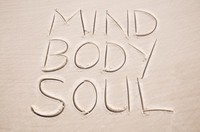Hair styles for boys changed radically in 1964. That was the year the Beatles appeared on The Ed Sullivan Show. Instantly, every kid in America wanted to drop the ubiquitous "crewcut" and grow long hair. At that time I was 11 years old and living in a small town in northern Wisconsin - and I had a terrible secret. One fateful day, while we were playing dodge ball in gym class, my terrible secret, was exposed. My teacher had spotted a massive bald spot on top of my head. I had always meticulously covered it over with hair from the sides so no one would know, even my parents. I would die of embarrassment if any of the other kids knew that I was bald, and worse, that I pulled the hair out, one by one, and then ate it.
Once my horrible secret was discovered, my mother took me to the barber shop and had my head shaved. That was her solution to the problem. Many other people with trich have tried this. It never works. Once the hair grows back, one simply begins pulling it out again. In 1964, in Appleton, Wisconsin, no one had any idea what an "impulse disorder" was. Most of my "therapy" consisted of relatives shouting at me: "Just stop it!" in frustration.
35 years later, I was doing in-home therapy for autistic children in Brooklyn. One day, while writing notes on a session in front of the tv by one of my kids, his mother was watching a show about compulsive hair pulling. It immediately drew my attention. When they mentioned the word: "trichotillomania," I jumped off the couch and said, "What? There's a name for this? Other people do it too?"
I was dumbfounded. When I got home that day, I immediately went to my computer and "googled" that funny sounding name. That was the beginning of a long search in books, articles, research papers, etc. Here's what I found.
Trich (short for trichotillomania, also referred to as "TTM") is
a "self-induced and recurrent loss of hair." It affects up to 4% of the population and is, reportedly, more common in women. It is classified in the DSM-IV as an impulse control disorder on the obsessive-compulsive spectrum with other disorders such as nail and cheek biting, skin picking and eating disorders. There are three distinct subgroups by age: preschool age children, pre-adolescents to young adults and adults. It is also subdivided into "automatic" versus "focused" hair pulling with children usually in the automatic, or subconscious subtype while older people may have focused, conscious ritual associated with it including, pulling only specific types of hair or from certain areas on the head. Others pull only after twirling and feeling "right" for that particular hair. Some pull out only eyelashes and/or eyebrows.
I had the ritual type. (I say "had" because I stopped pulling at age 15 though the urge continues). Pulling for me had to "feel right." I pulled from only the left side of my head. I had no impulse nor received no satisfaction from pulling anywhere else. After a hair was pulled, I had to bend it a certain way and then, eat it. Eating hair is called: trichophagia and can lead to "Rapunzel syndrome," which is a build up of hair in the digestive tract that can be fatal if misdiagnosed.
What could possibly cause one to start such an unusual behavior? It is not clear. There are schools of thought ranging from anxiety, depression and stress to a neurocognitive model focusing on the frontal lobes of the brain which have to do with habit formation. A recent study at the Center for Human Genetics at Duke University led by Dr. Allison Ashley-Koch has identified a gene (SLITKR1) that is common in 5% of those with the disorder. She says that this small finding may open the door to understanding the underlying biological causes helping lead to better treatments.
There are various treatments for TTM but no cures. One treat-ment with a moderatelyhigh success rate is called: Habit Reversal Training. This is a "cognitive behavioral therapy" based on recognizing impulses, redirecting the urge to another activity, motivational reward systems, and generalizing the replacement activity to other environments.
Medications such as those used for OCD and depression, SSRI's like Prozac, etc., used in combination with behavioral techniques have been helpful to many of those who suffer from the disorder.
A study by Dr. Jon Grant at the University of Minnesota's Medical School has shown promising results of the use of an over the counter dietary supplement called N Acetyl Cysteine or NAC. In a double blind, clinical study with 50 people, 56% of people on the supplement reported drastically reducing their pulling after nine weeks. However, before trying this supplement, it is highly
recommended to first review the findings and consult with your doctor. A review of the study can be found at "trich.org. This website is the most important source for TTM available. The website is posted by an organization, called TLC or, Tichotrillomania Learning Center and was started by a woman with the disorder. It is
a large organization with a newsletter, conventions, retreats, expert panel members, and current updates on research.
There are books, videos and other websites devoted to dealing with TTM. I highly recommend the book: The Hair Pulling Problem by Fred Penzel.
If you are interested in seeing others with the disorder, you might want to go to You Tube and write in "trichotillomania." There you will find many people talking about their struggles with it and reports by professionals.
In New York, there is a weekly meeting every Tuesday night in Manhatten. Contact information is on the www.trich.org website.
Benyamin Wolfson, M.ED.
Benyamin Wolfson is a board certified behavior analyst presently working with autistic children in Brooklyn NY and can be contacted at [email protected]

 Previous
Previous

